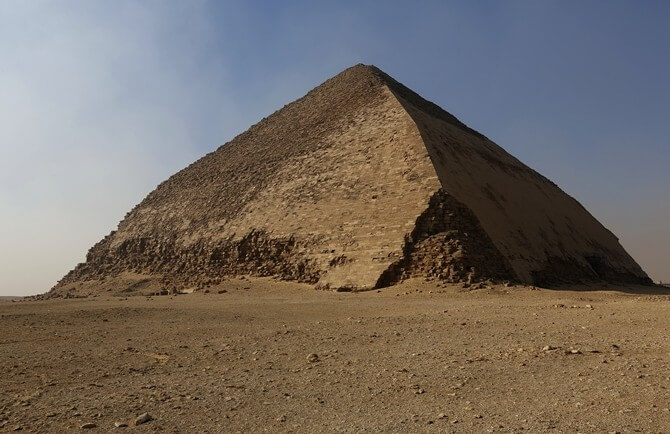 1
1

Tutankhamun's dagger comes from space
 01. 05. 2024
01. 05. 2024



 1
1

 01. 05. 2024
01. 05. 2024

 30. 04. 2024
30. 04. 2024


 28. 04. 2024
28. 04. 2024
 4
4
 19. 04. 2024
19. 04. 2024

For the first time, the interior of the ancient Egyptian pyramid was discovered using cosmic particles.
The new technology was used in the 4500 years of the old Lomé Pyramid, which gained its name due to the lofty shape of the top of the walls.
According to scientists who recently presented their results in Cairo to Egyptian Minister of Monuments Kaledom El-Enany and former Minister Mamdouh El-Damaty, the results are excellent and capture the interior of the building.
Technology uses muons, cosmic particles that flow naturally to Earth and are able to pass through any material.
The Angled Pyramid is the first pyramid to be explored in the Scan Pyramids project implemented by a team from the Faculty of Mechanical Engineering of the University of Cairo and the non-profit organization Heritage, Innovation and Preservation in Paris under the auspices of the Egyptian Ministry of Monuments. Other pyramids should be the Great Pyramid of Giza and the Red Pyramid of Dahshur.
The project is expected to last a year and uses a combination of innovative technologies such as infrared thermography, muon radiography and 3-D reconstruction for better examination of buildings and possible detection of the presence of unknown internal structures and cavities.

The broken pyramid is located in the royal necropolis of Dahshur, about 25 miles south of Cairo, and was probably built during the reign of Pharaoh Senephr in the Old Kingdom (about 2600 BC). It is the first pyramid with a smooth surface built after generations of stepped pyramids.
The building has two entrances - one on the north and one on the west side. Through these entrances, one enters two corridors, which open into the burial rooms lying above each other.
There has been speculation that Pharaoh Senefru's body is located inside a pyramid in an undiscovered burial room, but new technology has refuted this hypothesis. Scanning did not detect the presence of any additional chamber the size of the upper chamber.
"It's a real scientific breakthrough, because the new methods applied to the Egyptian pyramids have really worked. This paves the way for further research, "said Mehdi Tayoubi, one of the Scan Pyramids project leaders, along with Hana Helal, a professor at the University of Cairo's Faculty of Mechanical Engineering and a former minister of research and higher education.
The results came four months after a research team led by expert Kunihir Morishim of the Institute for Advanced Research at the University of Nagoya in Japan installed 40 million detectors inside the lower chamber of the Lomena Pyramid.
The detectors contained two films with a muon-sensitive emulsion covering an area of about 10 square feet in the lower chamber of the pyramid. The detectors thus captured these particles flowing from space to the Earth's surface. The particles come from the upper layers of the atmosphere where they are formed by the collision of atomic nuclei with rays of cosmic radiation.
"Just as X-rays pass through our bodies, which allows us to visualize our skeleton, these elementary particles, which weigh about 200 times that of electrons, can very easily pass through any structure, even large rocks and mountains," Tayoubi said.
The detectors allow scientists to recognize the areas where the moon passes without problems, from more hilly areas where some of the mons are absorbed or reflected.
Morishimov's team selected detectors from the Loma Pyramid in January 2016 after 40 days of exposure. This is the maximum life of chemical emulsions at the temperature and humidity inside this pyramid. The films were then developed in a special laboratory installed at the Great Egyptian Museum and then sent to the University of Nagoya for analysis.
“More than 10 million million tracks were analyzed from the detectors. We count the muons and we are able to reconstruct the picture according to their distribution, ”said Tayoubi.
"For the first time ever, the internal structure of the pyramid was revealed using muon particles. The acquired images clearly show the second chamber of the pyramid, which is located about 60 feet above the lower chamber with emulsion plates installed, "he added.
Tayoubi admitted that available preliminary data from 40 days of exposure are not yet sufficient to accurately detect known corridors or unknown cavities smaller than those in the upper chamber.
Scientists made experimental simulations by placing hypothetical chambers of similar magnitude or size larger than the pyramid's upper chamber in the field of vision.
"These simulations could have helped detect the presence of other chambers of similar size in the neighborhood," said Professor Morishima.
After these results, scientists will now apply a new method in the Old Pyramid of the Old Empire.
Next in line will be the Great Pyramid of Giza, the last wonder of the old world.
There have long been rumors about this monument, that there are hidden passages inside that lead to secret chambers.
Scientists are planning to use two other procedures, besides the above-mentioned method from Nagoya University.
"Unlike emulsions, they have a lower resolution but no limit at the time of exposure and further enable real-time analysis," Tayoubi said.